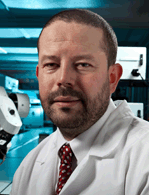Other Track AgendasBiobanking: Preparation, Storage & Analysis | Chemistry Automation & Liquid Handling | Drug Discovery Automation: High-content Screening & Cell Based Assays | Nano & Microfluidics | Next-Gen Sequencing |

Thursday, 6 June 2013 |
3D and Complex Cell Based Models for HCA | Session Sponsors |
| | 08:00 | Registration | 09:00 |  | Keynote Presentation The Deployment and Evaluation of Advanced 3DTechnologies for High Content and High Throughput Screening
Anthony Mitchell Davies, Director, Trinity College Dublin, Ireland
Over the last 5 years we have been engaged in an intense research program focused on the development of novel research technologies specifically aimed at improving the biological relevance of in vitro cell based assays. The latest addition to our technology portfolio is a completely novel cell suspension technology that has been developed to simplify the process of growing cells in 3 dimensions. |
| 10:00 | Coffee & Networking in Exhibition Hall | 10:45 | Goodbye Petri Dish - Complex Cell and Tissue Culture Models for Drug Discovery and Toxicology
Matthias Nees, Principal Scientist, VTT Technical Research Centre, Finland
The talk will introduce standardized and miniaturized, organotypic co-culture methods that allow mimicking the impact of cell-cell interactions, extracellular matrix and the (tumor) microenvironment on morphology and phenotype of complex epithelial tissues. Real time, live cell imaging and automated image analysis tools will be introduced. These enabling platforms allow high content screening and assays for drug discovery, target validation, and toxicology. | 11:30 | From Cell Lines to Primary Cells and 3D Models - Challenges in High-content Screening
Robin Ketteler, Group Leader/Manager, University College London, United Kingdom
I will present High-Throughput Screening approaches in primary cells and cell lines using siRNA, cDNA or small molecule compounds in order to study cell biology phenomena. | 12:15 | Lunch & Networking in Exhibition Hall | 13:30 | Poster Viewing Session | 14:15 | 3D and 2D Small Molecule High-content Screens Identify Novel Autophagy Regulator Kinase Inhibitors
Janos Kriston-Vizi, Investigator Scientist, University College London, United Kingdom
We developed 3D and 2D cellular high-content screens in order to identify potent kinase inhibitor compounds that regulate autophagy. I discuss our results, where a diverse kinase inhibitor compound library was screened against our A549 LC3-eGFP-mCherry lung cancer cell line.
| 15:00 | Automated Microinjection of Cell-polymer Suspensions in 3D ECM Scaffolds for High-throughput Quantitative Cancer Invasion Screens
Jan de Sonneville, CEO, Life Science Methods B.V., Netherlands
Automated microinjection of cancer cells in collagen gel allows for instant 3D cell spheroid formation. Subsequent RNA-i screening is used to discover targets affecting cell migration and survival. Example: prostate cancer; a new kinase inhibitor shows the translational power in 3D cells spheroids, zebrafish, mice and human tissue.
| 15:45 | Coffee & Networking in Exhibition Hall | 16:30 | CANCELLED - From High Throughput Screens to Biomedical Knowledge
Frank Buchholz, Professor, University of Technology Dresden, Germany
| 17:15 | A Platform for Personalized Cancer Patient Treatment Selection based on ex vivo Drug Sensitivity Testing and Molecular Profiling
Krister Wennerberg, Group Leader, Institute for Molecular Medicine Finland, Finland
I will describe a multiplexed drug sensitivity testing platform that is used on primary leukemic patient cells to gain understanding of the molecular mechanisms of the disease and to identify novel effective personalized therapies for refractory cancers. | 18:00 | Understanding Melanoma Cell Form using Genetics and Computer Vision.
Chris Bakal, Dynamical Cell Systems Team Leader, Institute of Cancer Research, United Kingdom
I will discuss how we have gained new genes insights into melanoma metastasis through novel computational analysis of high-throughput RNAi screens.
| 18:45 | End of Day One |
Friday, 7 June 2013 |
HCA/HTS RNAi and Compound Library Screening |
| | 08:15 |  | Keynote Presentation Illuminating Cellular Pathways through Combining High Content Assays with the BDA Method: Too Much Hay and Very Few Needles in Random RNAi Screening Stacks
Hakim Djaballah, CEO, Institute Pasteur - Korea, Korea South
Developing the appropriate and sensitive cell based assay together with the choice of methodology for hit nomination in random RNAi screening remain the main challenges as well as pitfalls for the technology. Automated microscopy-based assays offer the provision and availability of an image allowing visual inspection for acceptance or complete rejection of a perturbed phenotype caused by a given RNAi molecule in an arrayed screen. |
| 09:15 | siRNAs, Small Molecules and Drug Repurposing: Combined Screening Approaches to Targeting Cancer
Emma Shanks, Head of Screening, Beatson Institute for Cancer Research, United Kingdom
Our combination approach using siRNA libraries with small molecule High Content screening has elucidated putative novel players across multiple cancer backgrounds. Moreover, our work with drug repurposing adds breadth to our hit deconvolution and elucidation of potential novel therapeutic combinations. | 10:00 | Coffee & Networking in Exhibition Hall | 10:45 | Plate Reader versus High Content RNAi Screens. Who's Right?
Stephen Brown, RNAi Facility Screening Manager, Sheffield University, United Kingdom
I run a national genome-wide RNAi screening facility. Most assays carried out in our facility are high content screens, investigating basic research or biomedical pathways. In this presentation I will reveal some of the assays carried out at our laboratory and some of the rules and tricks that we use. | 11:30 | BioAssay Ontology (BAO) and the LINCS Information FramEwork (LIFE) to Integrate and Analyze Diverse High Throughput and Cellular Profiling Assay Data
Stephan Schurer, Assistant Professor, University of Miami, United States of America
BAO enables standardized description, integration and meta--analysis of various high throughput and profiling assay and screening results. We illustrate our ontology--driven approach using data generated in the Library of Integrated Cellular Network--based Signatures (LINCS) Program. LIFE is a semantically enabled software system to exchange, query and explore these datasets. | 12:15 | Lunch & Networking in Exhibition Hall | 13:30 | Poster Viewing Session | |
Novel Approaches to Cell Based Screening and Image Analysis |
| | 14:15 | Imagopole - Leveraging the Power of Automation and HCA on Infectious Disease Models for Basic Science, Drug Screening and Personalized Medicine.
Nathalie Aulner, Senior Researcher, Institut Pasteur, France
Analyses of infectious disease requires sophisticated imaging workflows to follow host-pathogen interactions from molecule, to cell, to tissue, and ultimately in vivo. Automation of the necessary technologies also requires safe bio-containment (e.g. BSL2/BSL3). We will present our efforts towards addressing some of the major challenges to achieve such studies. | 15:00 | Chemistry of Ubiquitination, Proteolysis and Antigen Presentation.
Huib Ovaa, Group Leader, Netherlands Cancer Institute, Netherlands
In this lecture I will show: 1. how ubiquitin conjugates can now be synthesized by total synthesis. 2. how new chemical tools allow us to study proteasome activity; and 3. How chemical methods facilitate the study of T-cell reactivity.
| 15:45 | Coffee & Networking in Exhibition Hall | 16:15 | CANCELLED - Intelligent High Content Screening Platforms for Large Scale in vivo Screens
Urban Liebel, Group Leader/Head, Karlsruhe Institute of Technology, Germany
We present several compound screening strategies for probing inflammatory effects, heartbeat, morphological readouts and tissue expression profiling methods and discuss the data challenge and solutions. | 17:00 | Close of Conference |
|

 Add to Calendar ▼2013-06-06 00:00:002013-06-07 00:00:00Europe/LondonDrug Discovery Automation: High-content Screening and Cell Based AssaysSELECTBIOenquiries@selectbiosciences.com
Add to Calendar ▼2013-06-06 00:00:002013-06-07 00:00:00Europe/LondonDrug Discovery Automation: High-content Screening and Cell Based AssaysSELECTBIOenquiries@selectbiosciences.com